Attached files
| file | filename |
|---|---|
| 8-K - FORM 8-K - ANALOG DEVICES INC | b83580e8vk.htm |
Exhibit 99.1


| This presentation contains forward-looking statements, including with respect to expected financial results, sales growth and customer demand, business strategy, market share, cost-reduction efforts, capital spending, expected dividend payments, and expected market conditions. Such forward- looking statements are based on our current expectations, beliefs, assumptions, estimates and projections, and are inherently uncertain. Actual outcomes and results may differ materially from what is expressed in such forward-looking statements, and such statements are not guarantees of future performance and should not be relied upon as representing Analog Devices' expectations or beliefs as of any date subsequent to the date hereof. We do not undertake any obligation to update forward-looking statements made by us. Important factors that may affect future operating results include: any faltering in the apparent improvement of economic conditions and financial markets following the global credit and financial market crisis over the past two years, erosion of consumer confidence and declines in customer spending, the effects of declines in customer demand for our products and for end products that incorporate our products, competitive pricing pressures, unavailability of raw materials or wafer fabrication, assembly, and test capacity, any delay or cancellation of significant customer orders, changes in geographic, product, or customer mix, inability to license third party intellectual property, inability to meet customer demand, adverse results in litigation matters, and other risk factors described in our most recent filings with the Securities and Exchange Commission. During today's presentation, we may refer to non-GAAP financial measures that have been adjusted for one-time items in order to provide investors with useful information regarding our results of operations and business trends. Reconciliations of these non-GAAP measures to their most directly comparable GAAP measures can be found in our earnings releases which are posted on the IR website. Safe Harbor Statement |
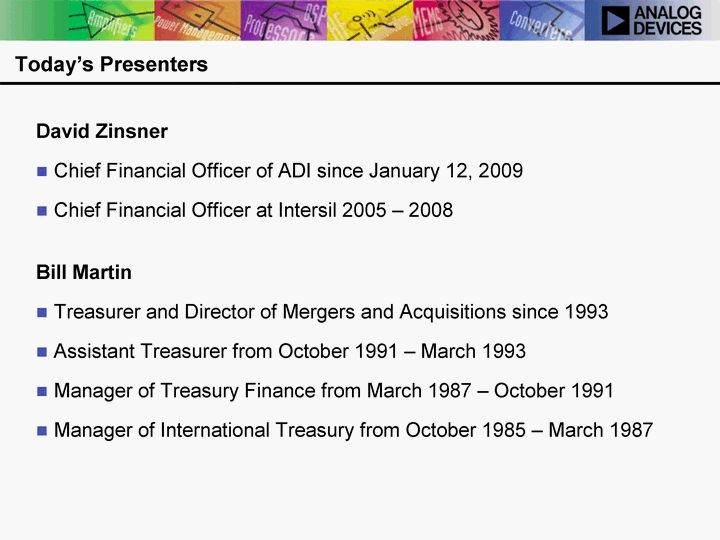
| 2 Today's Presenters David Zinsner Chief Financial Officer of ADI since January 12, 2009 Chief Financial Officer at Intersil 2005 - 2008 Bill Martin Treasurer and Director of Mergers and Acquisitions since 1993 Assistant Treasurer from October 1991 - March 1993 Manager of Treasury Finance from March 1987 - October 1991 Manager of International Treasury from October 1985 - March 1987 |

| 3 Key Investment Highlights Highly diversified business model with broad exposure to multiple products, customers, end markets and geographies Leading market position with attractive growth prospects Highly-proprietary products with long product life cycles and high margin profile Efficient cost structure and low capital requirements Consistently high-quality financial results with proven ability to generate strong cash flows through the cycle Conservative capital structure strategy Experienced management team with demonstrated ability to steer business through cycles ? ? ? ? ? ? ? |
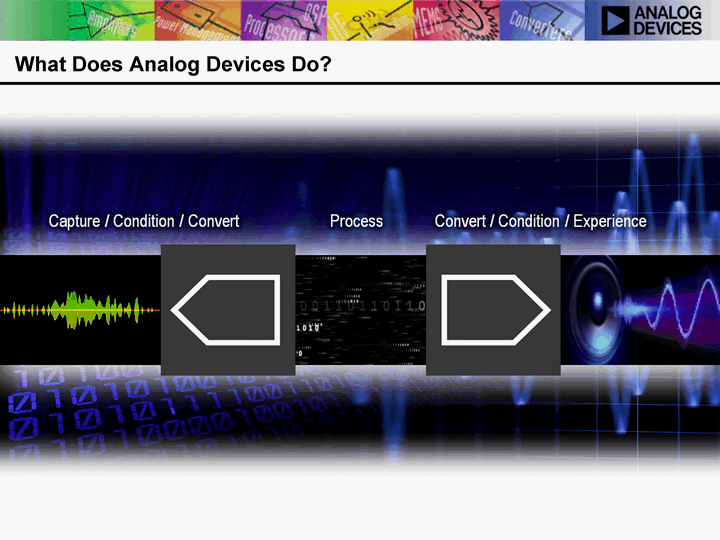
| 4 What Does Analog Devices Do? |

| 5 Experienced Management Team 132 Years of Combined Service With ADI President & CEO Jerry Fishman CTO Sam Fuller, VP Human Resources Bill Matson, VP Legal Marnie Seif, VP Core Technologies Mass Markets Market Segments WW Sales Finance Dave Zinsner, VP Core Products & Technologies Robbie McAdam, VP WW Manufacturing Rob Marshall, VP Strategic Market Segments Vincent Roche, VP |

| 6 Worldwide Standard Linear Analog IC Consumption by End Market 2004 - 2014E ($Bn) Long product life cycles Proprietary products Large customer base Strong customer loyalty High fragmentation Stable ASPs 2004 2005 2006 2007 2008 2009 2010 2011E 2012E 2013E 2014E Communications 3.805 4.568 5.333 5.219 5.15 4.451 6.314 8.477 9.389 10.556 12.916 Data Processing 2.455 2.672 2.599 3.033 3.81 3.195 4.256 4.604 4.596 5.121 5.396 Consumer Electronics 4.54 4.491 5.225 5.536 5.106 4.488 5.766 5.697 5.799 6.068 6.343 Automative Electronics 1.135 1.262 1.475 1.722 1.63 1.282 1.899 1.749 1.774 1.829 1.913 Industrial Electronics 1.92 1.772 2.232 2.23 2.27 1.994 2.779 2.734 2.696 3.12 3.214 Attractive Market Opportunity Data Processing Consumer Industrial Automotive Source: iSuppli, 4Q 2010 update |

| 7 ... With Superior Analog Market Characteristics Worldwide Semiconductor Industry Revenue Analog ? Less Volatile 0 50 100 150 200 250 300 350 1984 1986 1988 1990 1992 1994 1996 1998 2000 2002 2004 2006 2008 2010 2012 ($) Average Digital Downturn (14%) Average Analog Downturn (7%) Digital ? More Volatile Analog is less volatile and higher margin than digital Digital Analog ? Less Volatile Source: SIA, November 2010 |

| 8 2010 Global Standard Linear Analog IC Market: $19.0 Billion Highly Fragmented Competitive Landscape Texas Instruments Analog Devices Nat Semi LTC Maxim STM ON Semi Intersil Fairchild NXP Other Source: iSuppli, 1Q 2011 update |

| 9 Product and Customer Diversification Over 60,000 total customers No customer represents more than 4% of total revenues The top 20 customers accounted for approximately 32% of revenues in FY2010 ? ? ? Customer Diversification Product Diversification Greater than 60% of product revenue is proprietary No one product currently accounts for more than 2% of total revenue Over 10,000 parts limiting reliance on any specific product ? ? ? Converters 47 Amplifiers 25 Other Analog Signal Processing 12 Power Management & References 7 DSP 9 Converters Amplifiers Other Analog Signal Processing Power Management and References DSP Source: Company data FY 2010 Revenue by Product Type |

| 10 FY2010 Revenue: $2.8 Billion End Market Diversification I&I 1266.5 Communications 595.7 Consumer 513.3 Computer 53 Automotive 333 Automotive 333 Computer Industrial and Instrumentation Industrial Automation Instrumentation Aerospace / Defense Security / Surveillance Building Automation Energy Healthcare Source: Company data Communications Cellular base stations Wired infrastructure Consumer Digital still camera Home entertainment Portable devices Automotive Safety Infotainment Power train |
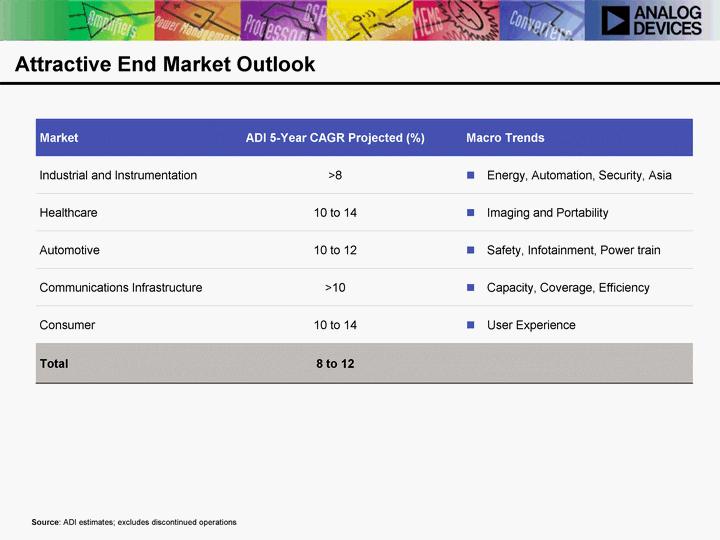
| 11 Attractive End Market Outlook Market ADI 5-Year CAGR Projected (%) Macro Trends Industrial and Instrumentation >8 Energy, Automation, Security, Asia Healthcare 10 to 14 Imaging and Portability Automotive 10 to 12 Safety, Infotainment, Power train Communications Infrastructure >10 Capacity, Coverage, Efficiency Consumer 10 to 14 User Experience Total 8 to 12 Source: ADI estimates; excludes discontinued operations |

| 12 Year of Release FY2005 FY2006 FY2007 FY2008 FY2009 FY2010 Long Product Lifecycles ADI Analog Products Source: Company data |

| 13 Converter Market Share (%) Source: Databeans: 2010 Data Converters, published June 2010 46 TI 19 Maxim 6 Linear 4 National 3 STMicro 3 Fairchild 3 Intersil 2 NXP 1 |

| 14 High Performance Amplifier Market Company ADI 2005 19.6 2006 20.5 2007 19.8 2008 21 2009 22.2 High Speed, High Precision, Instrumentation Amps ADI Share of Total Amplifier Market (%) Source: Databeans: 2010 Amplifier and Comparators Report, published May 2010 Converters 40 Amplifiers 60 2009 Worldwide Market Leader in High Performance Amps Source: ADI estimates; Databeans: 2010 Amplifier and Comparators Report, published May 2010. High performance includes high speed, high precision, and instrumentation amplifiers 40% |

| 15 Fab-Lite Manufacturing Strategy Diversified manufacturing strategy utilizing internal and external capabilities Internal capacity where process technology matters and product life cycles are long; external capacity for everything else Analog chip manufacturing does not require leading edge factories Completed the necessary investments to consolidate fabrication facilities over the past several years Results in low capital expenditure requirements |

| 16 ADI's Financial Model Stable, consistent revenue growth High margins Low capital spending High cash flow conversion Strong operating leverage Positioned effectively for recovery or continued recessionary environment Emphasis on organic growth and a conservative acquisition strategy ? ? ? ? ? ? ? |

| 17 Solid Long Term History of Revenue Growth... Revenue ($MM) Sales FY94 773.5 FY95 941.5 FY96 1193.8 FY97 1243.5 FY98 1230.6 FY99 1450.4 FY00 2577.5 FY01 2276.9 FY02 1707.5 FY03 2047.3 FY04 2633.8 FY05 2037.2 FY06 2250.1 FY07 2429.7 FY08 2582.9 FY09 2014.9 FY10 2761.5 1994 to 2010 Revenue CAGR: 8% Source: Company data Note: FY05 - FY10 metrics reflect revenue from continuing operations. |

| 18 Strong Margin Profile (%) Gross Margin OPBT FY92 46.8 4.6 FY93 47.3 9.4 FY94 49 13.2 FY95 50.7 16.8 FY96 50.3 19 FY97 49.9 18.8 FY98 47.8 12.8 FY99 49.3 16.7 FY00 56.7 29.8 FY01 55.7 17.9 FY02 53 6.9 FY03 54.9 18.3 FY04 59 26.6 FY05 61.7 22.8 FY06 61.9 23.4 FY07 62.1 23.4 FY08 61.1 24.2 FY09 55.5 14.1 FY10 65.2 32.6 Gross Margin Improvement Drivers Operating Margin 23%+ average operating margin over the last 5 years Source: Company data Note: FY05 - FY10 metrics are calculated as a percentage of revenue from continuing operations. Operating Expenses Improvement Drivers Fab consolidations Lower capital spending Improving mix Increasing utilization Pricing for value Product portfolio management Increased focus on ROI Better organizational alignment Reduced complexity |

| 19 Increasing Operating Leverage (%) 1Q07 2Q07 3Q07 4Q07 1Q08 2Q08 3Q08 4Q08 1Q09 2Q09 3Q09 4Q09 1Q10 2Q10 3Q10 4Q10 1Q11 TTM OPBT Drop-Thru % 35 13 -9 6 28 25 38 51 62 50 49 40 83 75 75 79 75 TTM Non-GAAP Operating Profit Drop-Thru (%) Source: Company data Note: Metric reflects results from continuing operations. Calculated as quarterly change in TTM non-GAAP operating income divided by quarterly change in TTM revenue. Items excluded from non-GAAP operating income include restructuring-related expenses, purchased in-process R&D, and non-recurring revenue from a 3rd party IP license. See the reconciliation table in the Appendix. |

| 20 Attractive Relative Operating Performance ADI vs. SOX and S&P Index Averages Operating Margin Gross Margin CY 2010 ADI 66.3 SOX 47.5 S&P 500 32.9 CY 2010 ADI 35 SOX 21.6 S&P 500 12.8 (%) (%) Source: ADI 10Q's - Continuing Ops. SOX and S&P500 provided by FactSet Market Aggregates SOX S&P 500 SOX S&P 500 |

| 21 Low Capital Spending Requirements ($) FY92 FY93 FY94 FY95 FY96 FY97 FY98 FY99 FY00 FY01 FY02 FY03 FY04 FY05 FY06 FY07 FY08 FY09 FY10 CAPEX $'s 65.7 67.2 90.9 212.7 234.1 179.4 166.9 77.5 274.8 297.2 57.4 67.7 146.2 85.5 129.3 141.8 157.4 56.1 111.6 CAPEX as a % of Revenue 11.6 10.1 11.8 22.6 19.6 14.4 13.6 5.3 10.7 13.1 3.4 3.3 5.6 4.2 5.7 5.8 6.1 2.8 4 Note: FY05 - FY10 metrics are calculated as a percentage of revenue from continuing operations. (%) CAPEX as a % of Revenue ADI's capital expenditures have moderated since the completion of the consolidation of its manufacturing facilities |

| 22 ...Leads to Significant Free Cash Flow Generation Free Cash Flow ($MM) FY94 FY95 FY96 FY97 FY98 FY99 FY00 FY01 FY02 FY03 FY04 FY05 FY06 FY07 FY08 FY09 FY10 95.7 -2.4 -90.4 106.3 71.2 364.9 429.7 546.4 168.7 365.2 631.8 587.2 491.8 678.6 512 376 879.6 12.4 -0.3 -7.6 8.5 5.8 25.2 16.7 24 9.9 17.8 24 24.6 19.1 25.1 19 18.6 31.9 (% of Sales) Free Cash Flow as a % of Revenues (1)(3) Source: Company data Notes: (1) Free cash flow defined as operating cash flow less CAPEX (2) FY05 - FY10 free cash flow includes free cash flow from discontinued operations. (3) FY05 - FY10 free cash flow as a % of revenue calculated as free cash flow divided by total revenue, including revenue provided by discontinued operations. |

| 23 ...and High Cash Flow Conversion Source: Company data. Note: FY05-FY10 free cash flow & net income metrics include results from discontinued operations and are calculated as a percentage of revenue, including revenue from discontinued operations. (1) Free Cash Flow defined as Net cash provided by operations minus CAPEX. (1) |

| 24 ADI Free Cash Flow Trend vs. Other "A" Rated Semi's (%) CY 2005 CY 2006 CY 2007 CY 2008 CY 2009 CY 2010 ADI 27 19 27 17 25 30 Intel 23 14 20 15 19 26 Texas Instruments 19 8 27 21 18 19 Applied Materials 18 18 20 12 12 16 Broadcom 15 22 18 19 22 18 % of Sales ADI Intel Texas Instruments Applied Materials Source: Company data and SEC filings |

| 25 Key Investment Highlights ? ? ? ? ? ? ? Highly diversified business model with broad exposure to products, customers, end markets and geographies Leading market position with attractive growth prospects Highly-proprietary products with long product life cycles and high margin profile Efficient cost structure and low capital requirements Consistently high-quality financial results with proven ability to generate strong cash flows through the cycle Conservative capital structure strategy Experienced management team with demonstrated ability to steer business through cycles |

| 26 Appendix |

| 27 Historical Income Statement FY05 (1) FY06 (1) FY07 (2) FY08 (1) FY09 (1) FY10 (1) Revenue (Continuing Operations) ($) 2,037 2,250 2,465 2,583 2,015 2,762 COGS 781 856 957 1,006 896 963 Gross Profit 1,256 1,394 1,508 1,577 1,119 1,799 Sales (%) 62 62 61 61 56 65 R&D 429 460 510 533 447 492 Sales (%) 21 20 21 21 22 18 SMG&A 331 384 390 416 333 390 Sales (%) 16 17 16 16 17 14 In-process R&D - 22 - - - - Special Charges 31 2 40 3 54 17 Operating Profit 465 526 568 625 285 900 Sales (%) 23 23 23 24 14 33 Net interest (Inc.) / exp (72) (100) (77) (41) (12) 1 Other Nop (Inc.) / exp - (11) (16) - (1) (2) Profit Before Tax 537 637 661 666 298 901 Income Taxes 172 118 159 141 50 190 Tax Rate (%) 32 19 24 21 17 21 Net Income - Continuing Ops ($) 365 519 502 525 248 711 Sales (%) 18 23 20 20 12 26 Income / (Loss) - Disc. Ops 49 30 (5) 261 - 1 Net Income ($) 414 549 497 786 248 712 Notes: (1) Discontinued operations results included with "Income / (Loss) - Disc. Ops." (2) Discontinued operations results included with "Income / (Loss) - Disc. Ops." Also includes $35 million revenue from one-time IP license. Source: Company data |
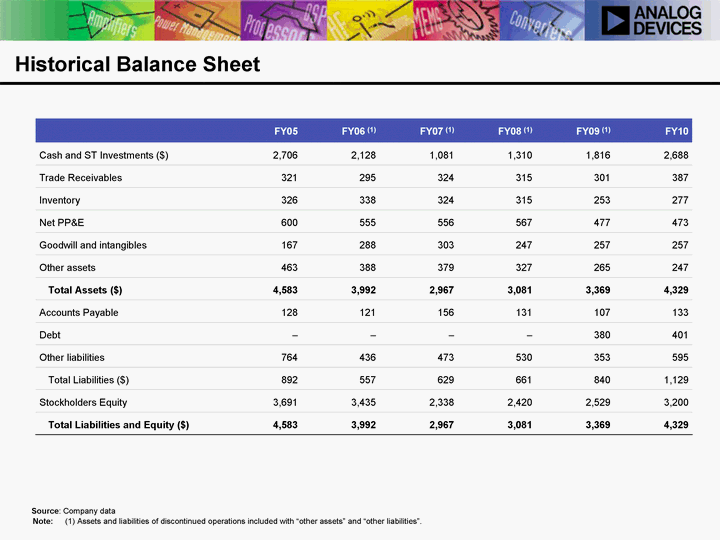
| 28 Historical Balance Sheet FY05 FY06 (1) FY07 (1) FY08 (1) FY09 (1) FY10 Cash and ST Investments ($) 2,706 2,128 1,081 1,310 1,816 2,688 Trade Receivables 321 295 324 315 301 387 Inventory 326 338 324 315 253 277 Net PP&E 600 555 556 567 477 473 Goodwill and intangibles 167 288 303 247 257 257 Other assets 463 388 379 327 265 247 Total Assets ($) 4,583 3,992 2,967 3,081 3,369 4,329 Accounts Payable 128 121 156 131 107 133 Debt - - - - 380 401 Other liabilities 764 436 473 530 353 595 Total Liabilities ($) 892 557 629 661 840 1,129 Stockholders Equity 3,691 3,435 2,338 2,420 2,529 3,200 Total Liabilities and Equity ($) 4,583 3,992 2,967 3,081 3,369 4,329 Note: (1) Assets and liabilities of discontinued operations included with "other assets" and "other liabilities". Source: Company data |
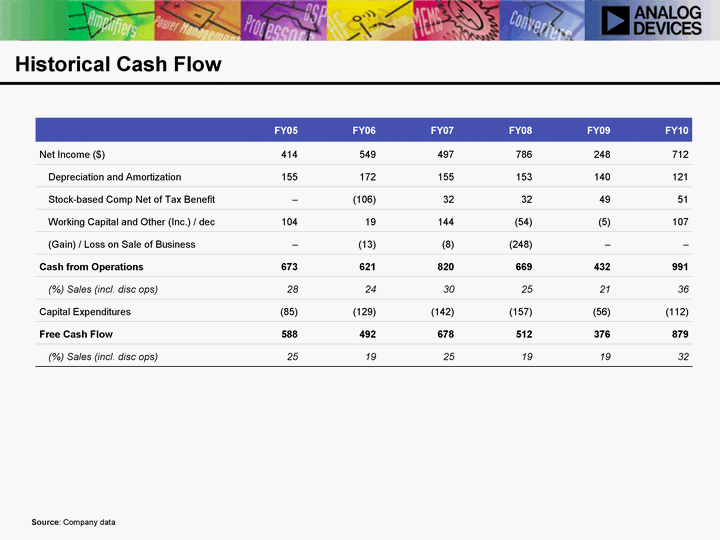
| 29 Historical Cash Flow FY05 FY06 FY07 FY08 FY09 FY10 Net Income ($) 414 549 497 786 248 712 Depreciation and Amortization 155 172 155 153 140 121 Stock-based Comp Net of Tax Benefit - (106) 32 32 49 51 Working Capital and Other (Inc.) / dec 104 19 144 (54) (5) 107 (Gain) / Loss on Sale of Business - (13) (8) (248) - - Cash from Operations 673 621 820 669 432 991 (%) Sales (incl. disc ops) 28 24 30 25 21 36 Capital Expenditures (85) (129) (142) (157) (56) (112) Free Cash Flow 588 492 678 512 376 879 (%) Sales (incl. disc ops) 25 19 25 19 19 32 Source: Company data |

| 30 This presentation includes non-GAAP financial measures for prior periods that are not in accordance with, nor an alternative to, generally accepted accounting principles and may be different from non-GAAP measures used by other companies. In addition, these non-GAAP measures are not based on any comprehensive set of accounting rules or principles. Manner in Which Management Uses the Non-GAAP Financial Measures Management uses non-GAAP financial measures, including non-GAAP EBITDA and non-GAAP operating income to evaluate the Company's operating performance against past periods and to budget and allocate resources in future periods. These non-GAAP measures also assist management in understanding and evaluating the underlying baseline operating results and trends in the Company's business. Economic Substance Behind Management's Decision to Use Non-GAAP Financial Measures The items excluded from the non-GAAP measures presented were excluded because they are of a non-recurring or non-cash nature: Restructuring-Related Expenses. These expenses are incurred in connection with facility closures, consolidation of manufacturing facilities, and other cost reduction efforts. Apart from ongoing expense savings as a result of such items, these expenses and the related tax effects have no direct correlation to the operation of our business in the future. Purchased In-Process R&D. We incur in-process research and development expenses when technological feasibility for acquired technology has not been established and no future alternative use for such technology exists. We exclude these items because these expenses are not reflective of ongoing operating results in the period incurred. Non-Recurring Revenue Associated with the License of Certain Intellectual Property Rights to a Third Party. On November 9, 2006, we received a one-time, non-recurring payment of $35 million in exchange for granting a license of certain intellectual property rights to a third party. This payment increased revenue in the first quarter of fiscal 2007 by $35 million. We exclude this item and the related tax effects from our non-GAAP results because it is a one-time item not associated with the ongoing operations of our business. Why Management Believes the Non-GAAP Financial Measures Provide Useful Information to Investors Management believes that the presentation of non-GAAP EBITDA and non-GAAP operating income is useful to investors because it provides investors with the operating results that management uses to manage the Company. Material Limitations Associated with Use of the Non-GAAP Financial Measures Analog Devices believes that non-GAAP EBITDA and non-GAAP operating income have material limitations in that they do not reflect all of the amounts associated with our results of operations as determined in accordance with GAAP and that these measures should only be used to evaluate our results of operations in conjunction with the corresponding GAAP measures. In addition, our non-GAAP measures may not be comparable to the non-GAAP measures reported by other companies. The Company's use of non-GAAP measures, and the underlying methodology in excluding certain items, is not necessarily an indication of the results of operations that may be expected in the future, or that the Company will not, in fact, record such items in future periods. Management's Compensation for Limitations of Non-GAAP Financial Measures Management compensates for these material limitations in non-GAAP EBITDA and non-GAAP operating income by also evaluating our GAAP results and the reconciliations of our non-GAAP measures to the most directly comparable GAAP measures. Investors should consider our non-GAAP financial measures in conjunction with the corresponding GAAP measures. Non-GAAP Financial Information |
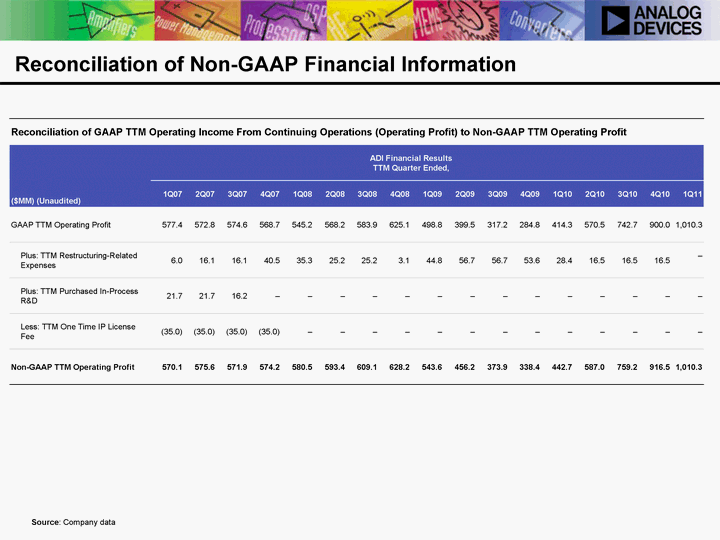
| 31 Reconciliation of Non-GAAP Financial Information Source: Company data Reconciliation of GAAP TTM Operating Income From Continuing Operations (Operating Profit) to Non-GAAP TTM Operating Profit Reconciliation of GAAP TTM Operating Income From Continuing Operations (Operating Profit) to Non-GAAP TTM Operating Profit Reconciliation of GAAP TTM Operating Income From Continuing Operations (Operating Profit) to Non-GAAP TTM Operating Profit Reconciliation of GAAP TTM Operating Income From Continuing Operations (Operating Profit) to Non-GAAP TTM Operating Profit Reconciliation of GAAP TTM Operating Income From Continuing Operations (Operating Profit) to Non-GAAP TTM Operating Profit Reconciliation of GAAP TTM Operating Income From Continuing Operations (Operating Profit) to Non-GAAP TTM Operating Profit Reconciliation of GAAP TTM Operating Income From Continuing Operations (Operating Profit) to Non-GAAP TTM Operating Profit Reconciliation of GAAP TTM Operating Income From Continuing Operations (Operating Profit) to Non-GAAP TTM Operating Profit Reconciliation of GAAP TTM Operating Income From Continuing Operations (Operating Profit) to Non-GAAP TTM Operating Profit Reconciliation of GAAP TTM Operating Income From Continuing Operations (Operating Profit) to Non-GAAP TTM Operating Profit Reconciliation of GAAP TTM Operating Income From Continuing Operations (Operating Profit) to Non-GAAP TTM Operating Profit Reconciliation of GAAP TTM Operating Income From Continuing Operations (Operating Profit) to Non-GAAP TTM Operating Profit Reconciliation of GAAP TTM Operating Income From Continuing Operations (Operating Profit) to Non-GAAP TTM Operating Profit Reconciliation of GAAP TTM Operating Income From Continuing Operations (Operating Profit) to Non-GAAP TTM Operating Profit Reconciliation of GAAP TTM Operating Income From Continuing Operations (Operating Profit) to Non-GAAP TTM Operating Profit Reconciliation of GAAP TTM Operating Income From Continuing Operations (Operating Profit) to Non-GAAP TTM Operating Profit Reconciliation of GAAP TTM Operating Income From Continuing Operations (Operating Profit) to Non-GAAP TTM Operating Profit ($MM) (Unaudited) ADI Financial Results TTM Quarter Ended, ADI Financial Results TTM Quarter Ended, ADI Financial Results TTM Quarter Ended, ADI Financial Results TTM Quarter Ended, ADI Financial Results TTM Quarter Ended, ADI Financial Results TTM Quarter Ended, ADI Financial Results TTM Quarter Ended, ADI Financial Results TTM Quarter Ended, ADI Financial Results TTM Quarter Ended, ADI Financial Results TTM Quarter Ended, ADI Financial Results TTM Quarter Ended, ADI Financial Results TTM Quarter Ended, ADI Financial Results TTM Quarter Ended, ADI Financial Results TTM Quarter Ended, ADI Financial Results TTM Quarter Ended, ADI Financial Results TTM Quarter Ended, ($MM) (Unaudited) 1Q07 2Q07 3Q07 4Q07 1Q08 2Q08 3Q08 4Q08 1Q09 2Q09 3Q09 4Q09 1Q10 2Q10 3Q10 4Q10 1Q11 GAAP TTM Operating Profit 577.4 572.8 574.6 568.7 545.2 568.2 583.9 625.1 498.8 399.5 317.2 284.8 414.3 570.5 742.7 900.0 1,010.3 Plus: TTM Restructuring-Related Expenses 6.0 16.1 16.1 40.5 35.3 25.2 25.2 3.1 44.8 56.7 56.7 53.6 28.4 16.5 16.5 16.5 - Plus: TTM Purchased In-Process R&D 21.7 21.7 16.2 - - - - - - - - - - - - - - Less: TTM One Time IP License Fee (35.0) (35.0) (35.0) (35.0) - - - - - - - - - - - - - Non-GAAP TTM Operating Profit 570.1 575.6 571.9 574.2 580.5 593.4 609.1 628.2 543.6 456.2 373.9 338.4 442.7 587.0 759.2 916.5 1,010.3 |

| 32 Reconciliation of Non-GAAP Financial Information Table of Reconciliation of GAAP Net Income (from Continuing Operations) to Non-GAAP EBITDA Table of Reconciliation of GAAP Net Income (from Continuing Operations) to Non-GAAP EBITDA Table of Reconciliation of GAAP Net Income (from Continuing Operations) to Non-GAAP EBITDA Table of Reconciliation of GAAP Net Income (from Continuing Operations) to Non-GAAP EBITDA Table of Reconciliation of GAAP Net Income (from Continuing Operations) to Non-GAAP EBITDA Table of Reconciliation of GAAP Net Income (from Continuing Operations) to Non-GAAP EBITDA ($MM) (unaudited) ($MM) (unaudited) ($MM) (unaudited) ($MM) (unaudited) ($MM) (unaudited) ($MM) (unaudited) ADI Financial Results ADI Financial Results ADI Financial Results ADI Financial Results Quarter Ended, Quarter Ended, Quarter Ended, Quarter Ended, 2Q10 3Q10 4Q10 1Q11 LTM GAAP Net Income (continuing operations) 167.1 199.5 225.0 215.6 807.2 Plus: Taxes 46.9 51.8 63.0 43.2 204.9 Plus: Interest Expense 2.6 2.6 2.7 2.8 10.7 Plus: Depreciation 28.9 28.6 29.3 29.5 116.3 Plus: Amortization of Intangibles 1.8 0.6 0.6 0.4 3.4 Plus: Stock-Based Compensation 13.3 13.2 13.5 12.6 52.6 Non-GAAP EBITDA 260.6 296.3 334.1 304.1 1,195.1 Source: Company data |

| 33 |
